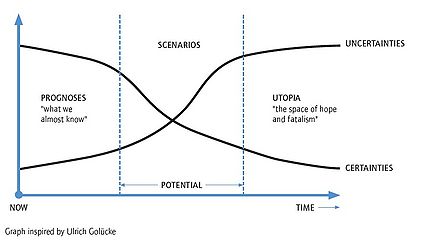Scenario Planning
Contents |
Abstract
Scenario planning can be thought of as stories that might happen in the future. With scenario planning is complex elements intertwined into a story that is coherent, systematic comprehensive and plausible. The scenarios should not only include visionary stories, but stories that also challenge the organization.[1] Scenario planning is used to help the organization to reach the right decisions in the event of different scenarios.
Scenario planning in businesses and thus construction management is divided into two categories. The first category is used to foresee a future state or condition, which is further used to simulate the choices and actions that may be taken to deal the scenario and the related consequences. The second category assumes that the choices has been established and the consequences are integrated into the story about the future state of the business. The first category simulates the thinking-process, and the second the exploring of the consequences of the choices taken. [2] Further in this article will scenarios be referenced to as a combination of these two categories.
Scenario planning has become a popular tool for businesses. The future is unknown, complex and it changes much faster than in previous times. Even though we do not know how the future will look like, we know that it will not look like the past or today, however, you can be involved in how it will unfold. As a business globalizes will the business, sometime in the future, be in the position where it must deal with costumers, regulators, culture, economic factors, etc. [2] Moreover, whichever scenario that become reality, will the business be more prepared with scenario planning.
Purpose
The primary purpose of scenario planning is to enable the decision makers, this includes the manager, to detect and explore, as many as possible, alternative futures to clarify the present actions and related consequences. The scenarios will inform and influence the decision makers. Fahey and Randall 1998 suggest that the purpose of scenario planning is to help seeing the potential future, how it might come about and why is it happening, and thus enlarging the understanding. [3] It will additionally explore how the organization might react if curtain circumstances occur, and thus identify the liable decisions. [4]
History
Scenario planning as a device for future planning was developed by Herman Kahn in the 1950’s. Khan was a central part of raising awareness of the US military, which is often referred to as the development of the nuclear war. In the 1970’s had the Royal Dutch Shell remarkable success after applying scenario planning, the company adjusted quickly after the OPEC oil shock in the 1970’s. [5] Shell is to this day, 10.06.17, still using scenario planning to help leaders explore ways forward and make better decisions.[6] It was also during the 1970’s that the consulting firm SRI International formulated a structural approach to scenario planning. [4] Moreover, it was with the report “The Limits of Growth to the Club of Rome” that scenario approach first entered the public’s awareness in 1972.[7]
Application
When to use the tool
Traditional planning tends to plan for an ideal future and listing the actions that should be taken to achieve this goal, however, the future is unknown and unexpected changes occur which moves the ideal future out of reach. [8]
It is hard to say when a construction manager should use scenario planning, however there are some conditions that would be in favor of applying it according to Paul J. H. Schoemaker’s “When and How to Use Scenario Planning: A Heuristic Approach with Illustration: [9]
- The uncertainty is high related to the company’s ability to predict or adjust
- The company has experienced too many unexpected costly surprises in the past
- The strategic planning has become too routinized and therefor the quality of strategic thinking is low
- The industry is experiencing changes or is about to
- There are strong differences of opinions and each have its qualities
- Etc.
How to use the tool
In scenario planning is multiple scenarios often used to categorize the range of how the future might evolve.
There have been attempts on shortcuts with only planning the best- and the worst-case scenarios with the actions related to these scenarios. However, the future is not black and white and the limited scenarios is most likely not sufficient. A future-thinking manager must plan for several scenarios based on the probable future situations that have been predicted from actual trends. Scenario planning requires however allot of resources and research. [8]
The scenarios should deal with a matter that is important for the business, at the same time shall the matter be associated with uncertainty – is it possible to give an answer of the development of the subject in the upcoming years. Moreover, should the business have a certain potential impact on the future. Further elaboration on the process of creating scenarios follows. [7]
Phases
References
- ↑ Ringland, Gill, Young, Laurie, "Scenario in Marketing: From Vision to Decision", 2006
- ↑ 2.0 2.1 Coats, Joseph F., "Scenario Planning", page 115-123, 2000, http://production.datastore.cvt.dk/filestore?oid=53a033d1ecd9f0954c085a67&targetid=53a033d1ecd9f0954c085a69
- ↑ Fahey, L., Randall, R.M., "Learning from the Future - Competitive Foresight Scenarios", New York: John Wiley & Sons, Inc., 1998
- ↑ 4.0 4.1 Ratcliffe, J. S., "Scenario Building: A Suitable Method for Strategic Construction Industy Planning?", Chicago, 2009
- ↑ Schumacher, "Constructing Vision with Scenario Planning", 2012 Proceedings of PICMET '12: Technology Management for Emerging Technologies, page 122-132, 2012
- ↑ Shell Scenarios [Online], Available: http://www.shell.com/energy-and-innovation/the-energy-future/scenarios.html , [Accessed 10 June 2017]
- ↑ 7.0 7.1 7.2 7.3 Sascha, Meinert, "Scenario Building", European Trade Union Institute, 2014
- ↑ 8.0 8.1 Isaacs, S. J., Construction Business owner, "How to Use Scenario Planning for Yours Construction Company", August 2011, Available: http://www.constructionbusinessowner.com/topics/strategy/construction-company-management/how-use-scenario-planning-your-construction-company/page/0/1, [Accessed 11 June 2017]
- ↑ 9.0 9.1 Schoemaker, Paul J. H, "When and How to use Scenario Planning: A Heuiristic Approach with Illustrations", In Journal of Forecasting, Chicago, page 549-564, 1991